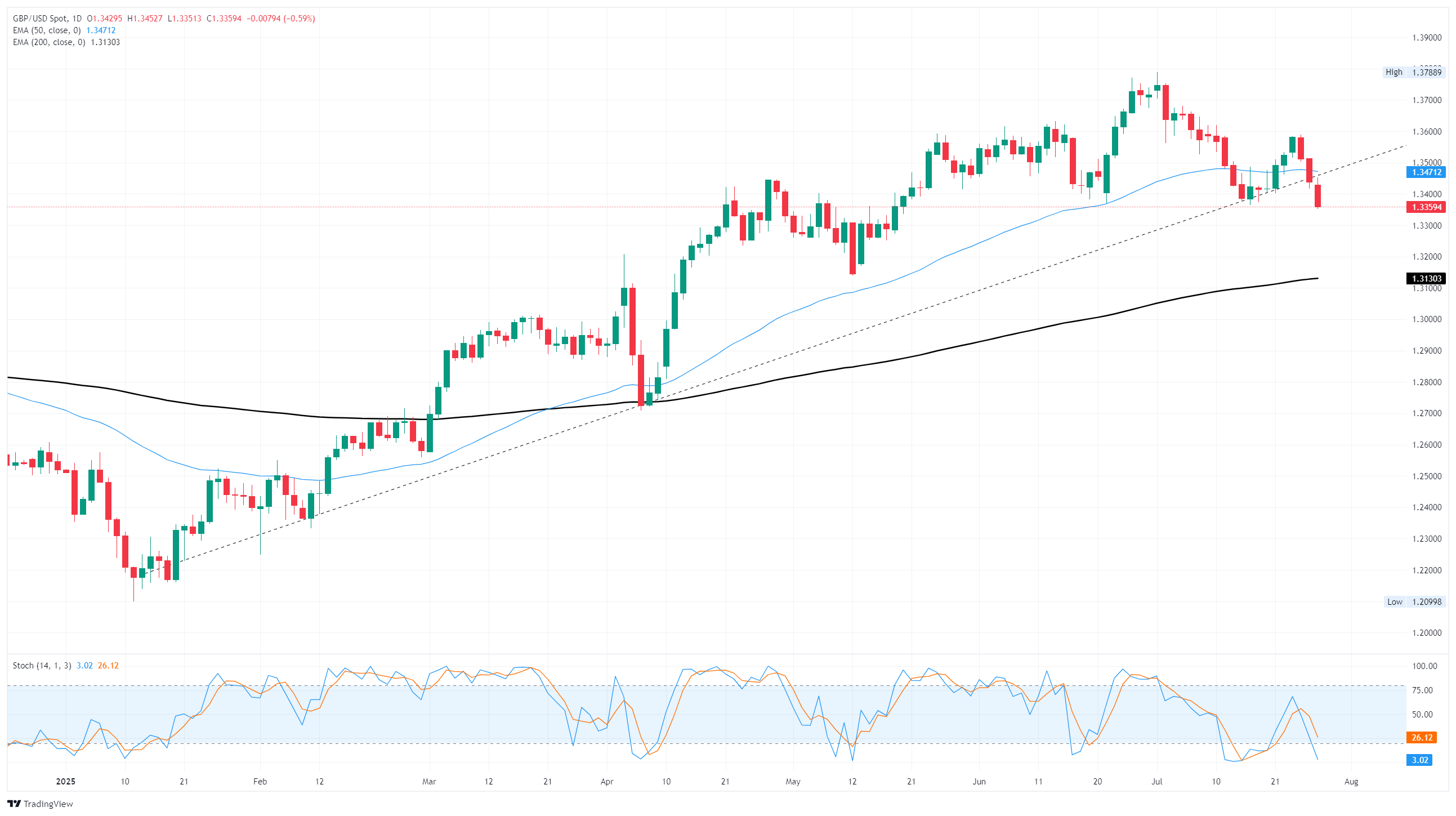GBP/USD extends into a third day of losses amid wider Greenback recovery
- GBP/USD tumbled back below 1.3400 on Monday as USD flows recover.
- A lack of UK-based economic data leaves a hefty US data docket in control.
- US GDP, Fed rate call, PCE inflation, and another NFP jobs report are all in the barrel.
GBP/USD caught another leg lower to start the new trading week, falling for a third straight session and tumbling back below the 1.3400 handle, hitting a ten-week low in the process. The US Dollar (USD) is rebounding across the board following months of weakness, kicking the Pound Sterling (GBP) below a key rising trendline.
The economic calendar is entirely clear of meaningful data releases on the United Kingdom (UK) side. However, Cable traders will have more than enough to keep them busy with a packed data docket on the American side of the Atlantic.
US data to dominate the data docket this week
United States (US) Gross Domestic Product (GDP) figures for the second quarter are slated to be released early on Wednesday, followed by the Federal Reserve’s (Fed) latest interest rate decision. Annualized US GDP is expected to rebound to 2.4% from Q1’s -0.5% print, while the GDP Price Index is forecast to ease to 2.4% from 3.8%. The Fed has been under increasing pressure from the Trump administration to trim interest rates fast and early, with President Donald Trump calling for a three-point reduction in the fed funds rate. Despite the White House’s protestations, the Fed is broadly expected to keep interest rates on hold this week, with hopes for a quarter-point rate cut in September.
Core Personal Consumption Expenditures Price Index (PCE) inflation data from June will be released on Thursday. Headline inflation figures hit a bump and run through the second quarter, with much of the blame laid at the feet of the Trump administration’s whipsaw trade and tariff policies. June’s PCE inflation index is expected to tick upward once again, rising to 0.3% MoM from the previous 0.2%.
Friday will close out a heavy week with the latest US Nonfarm Payrolls (NFP) data. Median market forecasts expect a slight easing in headline job additions, with investors expecting around 110K net new employed positions in July compared to June’s headline print of 147K.
GBP/USD price forecast
Cable weakness is back on the menu as downside momentum accelerates. GBP/USD is pushing back into the bearish side after flubbing a bullish push for the 1.3800 handle, failing to capture the key technical level in early July and pulling back into key moving averages below 1.3500. The pair has broken through a firm bullish trendline, and is now headed back toward the 200-day Exponential Moving Average (EMA) near 1.3130.
GBP/USD daily chart

Pound Sterling FAQs
The Pound Sterling (GBP) is the oldest currency in the world (886 AD) and the official currency of the United Kingdom. It is the fourth most traded unit for foreign exchange (FX) in the world, accounting for 12% of all transactions, averaging $630 billion a day, according to 2022 data. Its key trading pairs are GBP/USD, also known as ‘Cable’, which accounts for 11% of FX, GBP/JPY, or the ‘Dragon’ as it is known by traders (3%), and EUR/GBP (2%). The Pound Sterling is issued by the Bank of England (BoE).
The single most important factor influencing the value of the Pound Sterling is monetary policy decided by the Bank of England. The BoE bases its decisions on whether it has achieved its primary goal of “price stability” – a steady inflation rate of around 2%. Its primary tool for achieving this is the adjustment of interest rates. When inflation is too high, the BoE will try to rein it in by raising interest rates, making it more expensive for people and businesses to access credit. This is generally positive for GBP, as higher interest rates make the UK a more attractive place for global investors to park their money. When inflation falls too low it is a sign economic growth is slowing. In this scenario, the BoE will consider lowering interest rates to cheapen credit so businesses will borrow more to invest in growth-generating projects.
Data releases gauge the health of the economy and can impact the value of the Pound Sterling. Indicators such as GDP, Manufacturing and Services PMIs, and employment can all influence the direction of the GBP. A strong economy is good for Sterling. Not only does it attract more foreign investment but it may encourage the BoE to put up interest rates, which will directly strengthen GBP. Otherwise, if economic data is weak, the Pound Sterling is likely to fall.
Another significant data release for the Pound Sterling is the Trade Balance. This indicator measures the difference between what a country earns from its exports and what it spends on imports over a given period. If a country produces highly sought-after exports, its currency will benefit purely from the extra demand created from foreign buyers seeking to purchase these goods. Therefore, a positive net Trade Balance strengthens a currency and vice versa for a negative balance.

